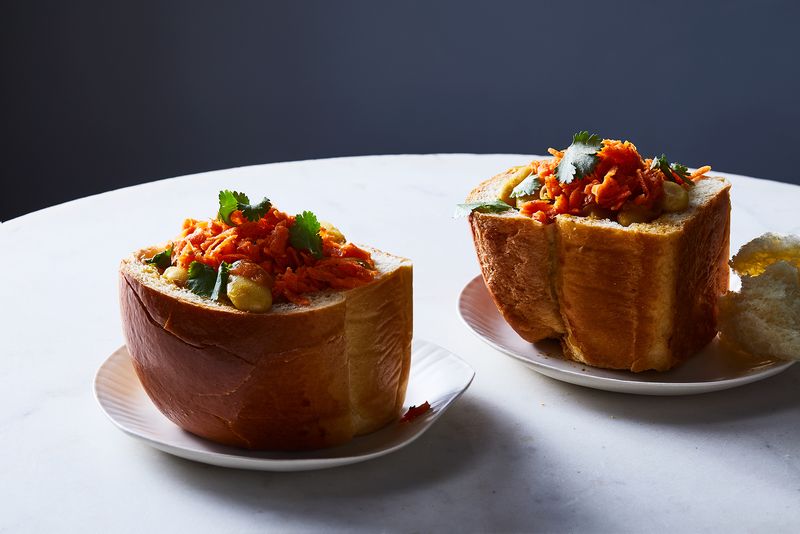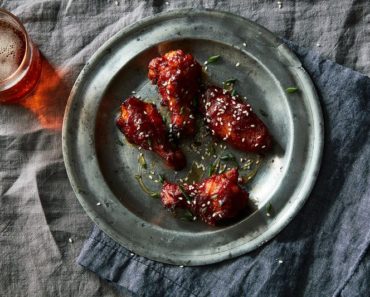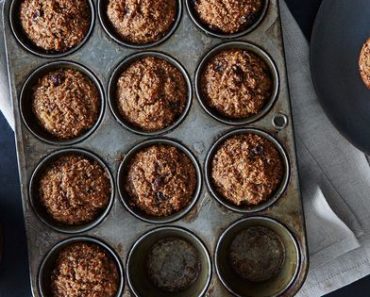These days, if I say “bunny chow,” it’s not likely I’ll hear “rabbit” in response. Back in 2013, Chris Ying did a curry spread featuring the South African specialty for the now defunct Lucky Peach, and you can find a “bunny,” as Durbanites call it, on restaurant menus from San Francisco to Brooklyn and in between. Simply, a bunny chow is a hollowed out quarter loaf of white bread filled to the brim with Durban-style curry, made with “gravy soakers,” a unique strain of floury potatoes called Up-To-Date, known for their melting quality. And it’s the Durban curry, more than the traditional standard-issue white bread into which it’s ladled, that makes the bunny chow unique.

by Ishay Govender-Ypma
As fiery as the dishes of Sri Lanka, as richly-colored as the South Indian curries of Tamil Nadu, but without the coconut, adorned with a customary slick of oil, and sometimes a jolt of tamarind, the Durban curry—the only curry named after a city, says Erica Platter, author of Durban Curry: So Much of Flavour People, Places & Secret Recipes—has become the working-class food hero of South African cuisine. This unique brand of curry journeyed with indentured laborers from India’s southern regions, who arrived from 1860 onwards to work on the British-run sugar plantations around Durban. Today, versions of these dishes can be enjoyed across South Africa.
The bunny chow’s origin story is shrouded in mystery, and not exactly rosy. Since Black citizens were forbidden from sitting in restaurants or tea rooms during apartheid, many postulate that the bunny was created in the 1940s to serve them a portable lunch. People also speculate that the creator was a Bania (Baniya) from the Indian merchant caste, as many spice and shop traders were at the time, and the name bunny chow derived from that. Soon, it became popular as a quick and convenient lunch that Indian, Black, and mixed-race laborers (like Durban’s former golf caddies, who could enjoy them during short lunch breaks).
Billy and Kanagee Moodley of the original Victory Lounge in Durban’s former Indian Quarter, established in 1945 (it closed for good in June 2017), claim the former Kapitans restaurant in the same area, was the first to serve the dish. Some claim the bunny chow was created at Queen’s Tavern (also long closed), and others credit Patel’s Vegetarian Refreshment Room, established 1932 and still run by the owner’s son, 75-year-old Manilal Patel. Mr. Patel’s responses to my bunny chow queries are monosyllabic, and as one of the last in the line of these old eateries, and with so few written records available, it’s hard to know for sure. There’s a good chance that the bunny chow was created by regular home cooks and simply replicated, to great success, by Durban’s Indian eateries. The truth lies somewhere between the speculative theories, but what remains is a dish South Africa’s East Coast is mighty proud of.
Many will insist that it’s a shame to leave South Africa without sampling at least one bunny chow filled to the brim with the king of Durban-style curries: tender, slow-cooked mutton, or sugar beans (dried borlotti beans), broad beans (large lima or butter beans), or a variety of other curries.
At under $3 for a vegetarian bunny, the curry’s fan base ranges from gourmands to the budget-conscious traveler who will seek out the plastic packet-wrapped meal-in-ones—no crockery or cutlery here! Use the piece of bread placed at the top like a lid to eat the curry from the center and work your way outwards. They often come with tiny but essential bags of vinegary grated carrot and green chili salad. The tools required? Your hands and plenty of serviettes. Water, or worse, cola, never helps with the burn, which according to the queen of spices Chandrika Harie, a 3rd generation heir and operations manager of Durban’s Spice Emporium. At its most authentic, Durban curry stings! But this is where the plentiful bread “container” plays its part: Chew on an untainted piece, before going back in for the curry sauce.
South African Bunny Chow With Butter Beans
-
2
14-oz cans canned butter beans, drained -
2
tablespoons sunflower or any vegetable oil -
1/2
large onion, sliced thinly -
1/4
teaspoon asafetida or hing (optional) -
1
small cinnamon stick -
1
star anise pod -
2
whole cloves -
1/2
teaspoon cumin seeds -
1
green chile, slit in half (optional) -
2
medium cloves garlic, crushed -
1/2
teaspoon grated fresh ginger root -
5-6
curry leaves (fresh or dried) -
1
ripe medium tomato, chopped -
2
teaspoons red masala (see note) -
1/2
teaspoon turmeric -
1
teaspoon ground cumin -
2
medium starchy potatoes, cut into 1-inch cubes -
1/2
teaspoon garam masala -
1
handful cilantro, picked and torn roughly -
Salt, to taste
-
Two unsliced loaves of white bread, using the ends for a “bowl”
Have you tried South African bunny chow? Tell us about your experiences below.
(via Food52)






